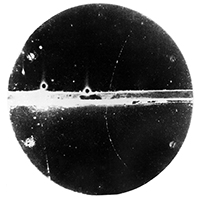Carl David Anderson
Biography
Carl David Anderson (September 3, 1905 – January 11, 1991) was an American physicist. He is best known for his discovery of the positron in 1932, an achievement for which he received the 1936 Nobel Prize in Physics, and of the muon in 1936.
Early Life
Carl David Anderson, who was born of Swedish parents - his father was Carl David Anderson and his mother Emma Adolfina Ajaxson - in New York City (USA) on 3rd September, 1905, has spent the bulk of his life in the United States.
Education
Carl David Anderson graduated from Caltech with a B.Sc. and a PhD in physics and Engineering in 1927 and 1930, respectively. His doctoral thesis and subsequent work as a postdoc dealt with X-rays. But soon cosmic rays were discovered by physicist Victor Hess (with whom Anderson would later share the Nobel Prize), and Anderson began research on these high energy particles.
Notable Discoveries
In 1932, Anderson, then a postdoc in the physics department at California Institute of Technology, was photographing the track of a cosmic ray particle in a cloud chamber. The track had an unusual curvature, and he deduced that it could only be produced by a particle “carrying a positive charge but having a mass of the same order of magnitude as that normally possessed by a free negative electron." He called this positively-charged electron a positron – the first identified antiparticle. For his accomplishment, Anderson shared the Nobel Prize for Physics in 1936. He was 31 years old.

A cloud chamber was the experimental piece of equipment of choice to study cosmic rays. Anderson designed and built his own cloud chamber and surrounded it with an electromagnet which caused the ionized particles to move on circular trajectories. When he examined the cosmic rays within the cloud chamber, he noticed that there appeared to be showers of both positively and negatively charged particles, as determined by the direction of curvature of the track. Moreover, the mass of the positively charged particles was smaller than a proton's. In order to prove that the particles were indeed positively charged, and not merely negatively charged electrons moving in the opposite direction, he put a lead plate in the chamber and captured his evidence in a now famous photograph. In the picture, a particle is seen approaching the metal plate from the bottom. When it hits the plate, it loses energy but continues to curve in the direction appropriate for a positively charged electron, which he later called a positron.
A few years after discovering the positron, Anderson and Seth Neddermeyer discovered mu-mesons (or muons).
Honors
Among the scientific honors bestowed upon him, in addition to the Nobel Prize awarded in 1936, may be mentioned the following: Gold Medal of the American Institute of City of New York (1935); Sc.D. of Colgate University (1937); Elliott Cresson Medal of the Franklin Institute (1937); Presidential Certificate of Merit (1945); LL.D. Temple University (1949); John Ericsson Medal of the American Society of Swedish Engineers (1960).
References
http://www.nobelprize.org/nobel_prizes/physics/laureates/1936/anderson-bio.html http://www.osti.gov/accomplishments/anderson.html https://www.aps.org/programs/outreach/history/historicsites/anderson.cfm